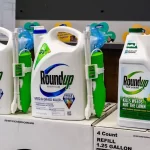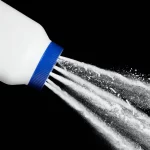Asbestos in Baby Powder
Since as far back as the 1960s, talcum powder has been under harsh scrutiny for its potential health risks. While studies are still ongoing on whether talc in itself is dangerous, scientists all agree that the main danger lies in the comorbidity of talc deposits and asbestos deposits, which often leads to asbestos-contaminated talc ore as it is mined. Since asbestos is a proven carcinogen, using contaminated talcum powder has a high risk of causing chronic conditions such as cancer. While asbestos is associated chiefly with lung conditions, let's explore the traits of talc and how it may be linked to a rarer type of cancer: ovarian cancer.
What is Talc?
Talc is a mined mineral that is known for its silky texture and moisture-absorption properties. Since it is mined from underground, talc often contains contaminants that must be filtered out, such as heavy metals like cadmium, cobalt, chromium, copper, iron, manganese, and nickel. Unfortunately, talc ore can also contain trace amounts of asbestos (a known carcinogen) because of asbestos' propensity for growing in or near talc deposits. Because talc is a common ingredient in many household products and cosmetics, it has been under scrutiny due to concerns over its possible asbestos contamination and the effects that it can have on those who come into contact with it.
Talc is technically considered a cosmetic mineral and, as such, is not regulated by the United States Food and Drug Administration (FDA). As a result, talc does not undergo the strict FDA processes that ensure anything we intentionally ingest is safe for consumption. This has allowed companies such as Johnson & Johnson, Colgate-Palmolive, and Revlon (among others) to misrepresent the harmful effects of their products over the years, seeing as talc is not meant to be ingested and is only unintentionally done. In addition, many in the cosmetic talc industry still claim to produce asbestos-free talc products even after experts found their industry tests to be outdated. Again, this could lead to asbestos-contaminated products through company negligence.
Common Products Containing Talcum Powder
You might be surprised with how many everyday products can still include talcum powder as an ingredient. Here is a handy list of examples for reference:
- Baby/body powders
- Face powders
- Makeup foundations
- Eyeshadows
- Blush/highlighter/contour powders
- Deodorants
- Feminine wipes/powders
- Chewing gums
- Food-based anticaking agents
- Ceramics
- Pottery
- Paints
- Roofing materials
- Joint compounds
- Plastics/rubbers
- Countertops
- Adhesives
And the list goes on! When in doubt, scour ingredient lists and conduct your research.
Common Manufacturers of Products Containing Talcum Powder
Unfortunately, many popular brands still manufacture many of their products using talcum powder, or have in the past. Some of the most common include the following:
- Arm & Hammer
- Avon
- Caswell-Massey
- Chanel
- Clubman
- Colgate-Palmolive
- Coty
- Estee Lauder
- Gold Bond
- Jeris
- Johnson & Johnson
- Liz Claiborne
- L'Oreal
- Mennen
- Revlon
- Vanderbilt Minerals
- Yardley
And many others.
Johnson & Johnson Talcum Powder Products
One of the most prolific ongoing trials concerning the effects of talcum powder usage involved the baby powder mogul Johnson & Johnson. Their talcum products, in particular, have been under intense scrutiny following recent trials that discovered there is a correlation between the use of talcum products and the development of ovarian cancer. However, it wasn't until May 2020 that Johnson & Johnson stopped selling their baby powder in the U.S. and Canada after years of investigations and trials that pointed to asbestos contamination in their baby powder.
In 2016, there were two trials against Johnson & Johnson. In the first case, a St. Louis jury awarded $72 million in damages after lawyers for the Plaintiff's Estate proved that the use of Johnson & Johnson's talc powder caused the decedent's ovarian cancer, which resulted in her death. Another St. Louis jury awarded $55 million for a living plaintiff whose ovarian cancer was in remission in the second trial.
Both juries found that Johnson & Johnson was negligent in the research, development, testing, marketing, and sale of their talcum powders, including Shower to Shower and Johnson & Johnson's baby powder. In addition, Johnson & Johnson failed to warn consumers of the increased risk of ovarian cancer when using talcum powder on the genital area.
Documents produced at trial showed that clinical studies in the 1970s and the 1980s showed that perineal use of talcum powder products caused an increased risk of ovarian cancer. Johnson & Johnson was accused of downplaying the epidemiological studies and ignoring requests by medical professionals to either warn of potentially harmful effects when using their talcum powder products or, failing that, remove their products from the market.
An official consultant of J&J advised the company to acknowledge the risk and warned of the correlation between use and ovarian cancer. In 2006, Imerys Talc America, who supplied the talc to Johnson & Johnson, began putting warning labels on talc shipped to Johnson & Johnson; however, the company failed to pass these warnings on to the consumers and users.
Ovarian Cancer and Illnesses from Talcum Powder
The World Health Organization recognizes talc as a possible carcinogen because of its potential to contain trace amounts of asbestos. When talcum powder is used in the genital regions of the body ー such as when using baby powder to prevent moisture, diaper rash, and chafing ー those particles can migrate into the vaginal canal to embed themselves into sensitive ovarian tissues, causing inflammation.
Unfortunately, our body does not have a successful way to remove these unwanted particles. This results in that area being perpetually inflamed. When one part of your body continues to receive persistent damage, it can result in cell mutations and eventually cancer in that area. In this case, it would result in ovarian cancer. The American Cancer Society, the International Journal of Gynecological Cancer, and the National Cancer Institute consider talcum powder use near the genitals a significant risk factor for ovarian cancer.
Let's talk about what to watch out for, what to expect, and what you can do if you are at risk of or have talcum powder-related ovarian cancer.
Ovarian Cancer Signs and Symptoms
Unfortunately, ovarian cancer is very difficult to detect early. This is because most of the signs and symptoms are somewhat vague, meaning that they can easily be attributed to other things such as menstrual symptoms, aging, weight gain, hormone imbalances, or less serious illnesses. However, these symptoms tend to occur more frequently and more severely when signaling the presence of ovarian cancer. Here are some common signs to look out for:
- Menstruation changes
- Abdominal bloating
- Abdominal pressure or pain
- Pain during intercourse
- Persistent back pain
- Feeling overly full after a meal
- Trouble eating due to feelings of fullness
- Urinary frequency
- Urinary urgency
- Pressure during urination
- Constant fatigue
- Constipation
If you have experienced any of the above symptoms more often than 10-12 days per month or more severely than usual, it's a great time to schedule a doctor appointment to investigate.
Ovarian Cancer Diagnosis
At present, there are no specific screening tests that can detect ovarian cancer in patients. Instead, doctors must rely on data resulting from several different tests and patient self-reporting to diagnose ovarian cancer. The most common diagnostic tests used to detect ovarian cancer include the following:
- Pelvic exams
- Transvaginal ultrasounds (TVU)
- Computerized tomography (CT) scans
- Blood tests (OVA1, Inhibin A and B, and CA-125 tests)
- Surgical staging (laparoscopy/laparotomy and biopsy)
These tests are used in tandem to determine if ovarian cancer may be present. Additional tests are then performed to determine if cancer has spread beyond the ovaries if cancer is detected.
Ovarian Cancer Stages
The stages used in cancer diagnoses are used to communicate cancer's progression and severity. The below information defines the various stages of ovarian cancer and what they mean.
- Stage 1: This is the earliest stage of ovarian cancer, where the cancer is only present in the ovaries themselves.
- Stage 1a: One ovary is affected.
- Stage 1b: Both ovaries are affected.
- Stage 1c: The risk of the cancer spreading is in evidence but has not yet occurred. This can happen when one of the following is true:
- Cancer cells are found in abdominal and pelvic fluids but not in the tissues.
- Cancer cells are found on one or both ovarian outer surfaces.
- Tissues encapsulating the tumor are ruptured before surgery can intervene.
- Tissues encapsulating the tumor rupture during surgery.
- Stage 2: Cancer has spread from the ovaries to other pelvic areas but hasn't yet spread to lymph nodes or other organs.
- Stage 2a: Cancer is found in the uterus and/or fallopian tubes.
- Stage 2b: Cancer is found in other organs located in the pelvis.
- Stage 3: Cancer has spread from the ovaries and pelvic area to the lymph nodes and/or other abdominal organs.
- Stage 3a: Cancer has either spread outside the pelvis or spread to lymph nodes found outside or behind the peritoneum.
- Stage 3b: Cancer has spread to the peritoneum itself but is 2cm or smaller. It may also be found in the lymph nodes behind the peritoneum.
- Stage 3c: Cancer has spread to the peritoneum itself but is larger than 2cm. It may also have spread to the abdominal lymph nodes or surfaces of the spleen or liver.
- Stage 4: Cancer has spread beyond the abdominal area, well beyond the primary source of cancer. This is known as metastatic cancer.
- Stage 4a: Cancer is found in the fluids surrounding the lungs.
- Stage 4b: Cancer has spread beyond the abdominal area but may exist in lymph nodes of the groin.
Ovarian Cancer Attorneys
If you or a loved one have experienced ovarian cancer due to talcum powder exposure, you may be entitled to compensation. Here at Serling & Abramson, P.C., we have a team of award-winning personal injury attorneys who are well-versed and experienced in talcum powder and asbestos litigation—and we can help. To find out more, feel free to book a free case evaluation with our personal injury experts today.
















